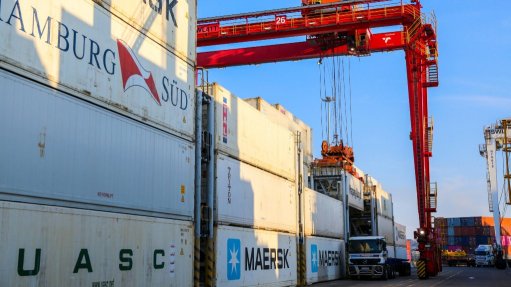Pipe lining solution protects against wear, reduces downtime
Engineers are moving away from using traditional rubber-lined steel pipes towards using linings that will reduce downtime and avoid plant abrasion through wear-protection products, such as polyurethane wear solutions, polyurethane expert company Urethane Moulded Products (UMP) tells Engineering News.
“The most cost-effective lining material on the market is polyurethane, but for the lining to meet expectation, its composition and the lining of the pipe must be undertaken by competent companies,” says UMP director Trevor Carolin.
He highlights that the consistent need for wear protection and reduced downtime have been the focus of the mining industry, owing to increased demands on equipment in terms of availability and mechanical wear pressures. Therefore, piping needs to sustain accelerated wear demands to last longer, as replacement costs, owing to the cost of the product and the resultant loss in production time, are significantly higher.
Polyurethane is an organic polymer containing the urethane group, which is core to the chemical structure of urethane. It is grouped with rubbers, owing to urethane and rubber being elastomers, which are created by allowing a polyol to react with a diisocyanate, notes the company.
“Polyurethane has been proved as cost effective in terms of proofing the pipe against abrasion, and as energy efficient, owing to its low coefficient of friction, which is up to five times greater than that of rubber. “Through better engineering design, one can ensure that the pipeline achieves the required durability that correlates with the projected life of the plant,” Carolin adds.
UMP notes that high-density polyethylene (HDPE) is the major material competing against polyurethane in the local market. When applied correctly, a polyurethane-lined pipe can outperform its competitors by a factor of three when conveying mine tailings and other process media. A test conducted at a phosphate plant, in South America, with 16 mm ore pumped at 3 m/s, showed that polyurethane-lined pipes in this application outlasted HDPE by a factor of 24.
“If a steel polyurethane-lined pipe com-mands a 41% premium over its closest rival, HDPE, the total life-cycle cost over a given period would work out to about 47%, compared with that of HDPE. “This comparison assumes that poly-urethane is a minimum of three times more wear resistant and does not take into account polyurethane’s superior performance with regard to high velocity, large particle sizes and bends,” he points out.
Carolin believes that the variations in the composition of polyurethane and its chemical resistance make it suitable for the mining industry as an abrasion-resistant and load-bearing material. The major advantages of polyurethane include tensile- and tear-strength elongation and rebound, chemicals and solvent resistance.
UMP says its branded Redline polyure-thane, in particular, allows for a thinner lining and a range of thicknesses to suit either the internal pipe diameter or the specific wear protection required. The product is also shatterproof and is not affected by thermal and external shocks.
“A mine will be able to become energy and financially efficient, in future, if it has a custom-designed pipeline, for its mineral processing plant, that uses wear liners suited to the specific sections of the pipeline. For example, this can include HDPE in the long straights and polyurethane in the bends and for various other fittings,” highlights Carolin.
UMP supplied its polyurethane products to mining company Richards Bay Minerals for use in its pipe launders, in KwaZulu-Natal, and to the pump stations at the Eastern Cape-based Coega harbour’s sand bypass pipeline, jet pumps and transfer points. The company also supplied polyurethane piping for titanium oxide company Ticor’s launder T-connectors, in Richards Bay.
Article Enquiry
Email Article
Save Article
Feedback
To advertise email advertising@creamermedia.co.za or click here
Comments
Press Office
Announcements
What's On
Subscribe to improve your user experience...
Option 1 (equivalent of R125 a month):
Receive a weekly copy of Creamer Media's Engineering News & Mining Weekly magazine
(print copy for those in South Africa and e-magazine for those outside of South Africa)
Receive daily email newsletters
Access to full search results
Access archive of magazine back copies
Access to Projects in Progress
Access to ONE Research Report of your choice in PDF format
Option 2 (equivalent of R375 a month):
All benefits from Option 1
PLUS
Access to Creamer Media's Research Channel Africa for ALL Research Reports, in PDF format, on various industrial and mining sectors
including Electricity; Water; Energy Transition; Hydrogen; Roads, Rail and Ports; Coal; Gold; Platinum; Battery Metals; etc.
Already a subscriber?
Forgotten your password?
Receive weekly copy of Creamer Media's Engineering News & Mining Weekly magazine (print copy for those in South Africa and e-magazine for those outside of South Africa)
➕
Recieve daily email newsletters
➕
Access to full search results
➕
Access archive of magazine back copies
➕
Access to Projects in Progress
➕
Access to ONE Research Report of your choice in PDF format
RESEARCH CHANNEL AFRICA
R4500 (equivalent of R375 a month)
SUBSCRIBEAll benefits from Option 1
➕
Access to Creamer Media's Research Channel Africa for ALL Research Reports on various industrial and mining sectors, in PDF format, including on:
Electricity
➕
Water
➕
Energy Transition
➕
Hydrogen
➕
Roads, Rail and Ports
➕
Coal
➕
Gold
➕
Platinum
➕
Battery Metals
➕
etc.
Receive all benefits from Option 1 or Option 2 delivered to numerous people at your company
➕
Multiple User names and Passwords for simultaneous log-ins
➕
Intranet integration access to all in your organisation


















